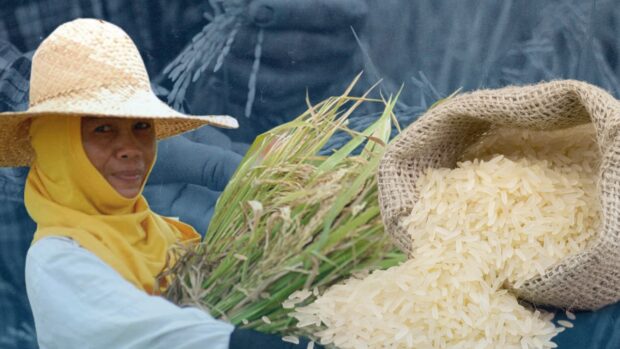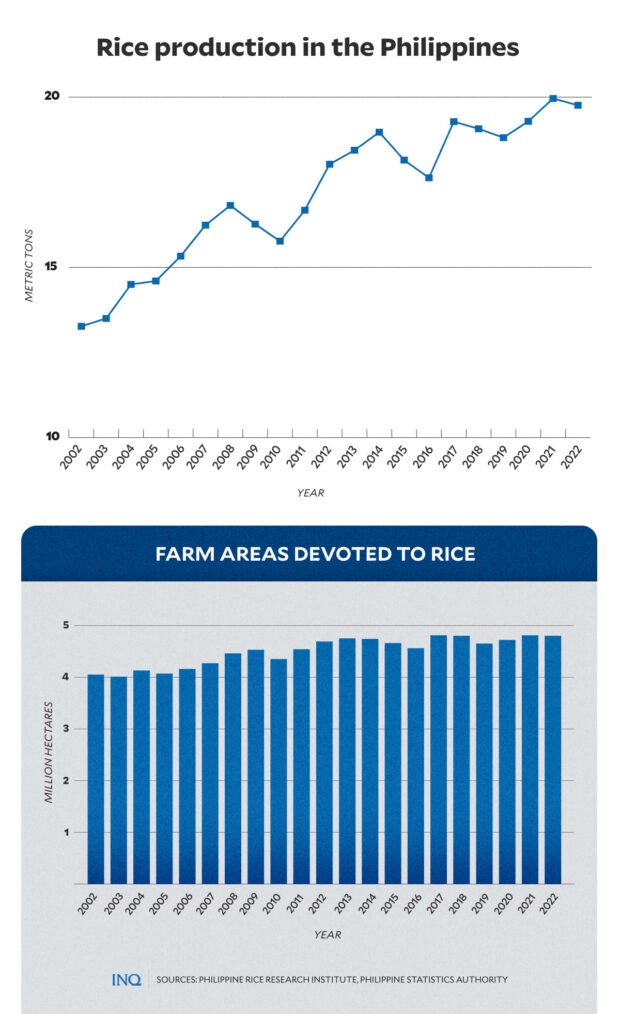Nat’l Rice Awareness Month: Farmers’ welfare, food self-sufficiency intertwined

RICE COMPOSITE IMAGE BY DANIELLA MARIE AGACER FROM INQUIRER FILE AND STOCK PHOTOS
MANILA, Philippines—The government, confronted with the problem of how to feed a continuously growing population which is expected to reach over 140 million by 2040 from 109 million in 2020, is encouraging Filipinos to buy locally produced rice.
This, as back in 2021, William Dar, who led the Department of Agriculture (DA) from 2019 to 2022, stressed that without significant steps to make farming worthwhile for Filipinos, the Philippines will have a “critical” shortage of farmers in 12 years.

GRAPHIC Ed Lustan
So as the Philippines marked the National Rice Awareness Month, the DA encouraged consumers to waste no rice and to procure the grain from local farmers, who are in dire need of enough income to provide for their families.
Every November since 2004, the year when Proclamation No. 524 was signed, the National Rice Awareness Month is observed to heighten awareness on efforts to attain food self-sufficiency and address poverty.
Last May, President Ferdinand Marcos Jr. said the government will work on achieving a 97.5 percent rice self-sufficiency goal by 2028, a downgrade from the DA’s previous target of 100 percent by 2027.
Article continues after this advertisementHe said 97 percent is already an adequate level for the population.
Article continues after this advertisementWhile it is doable, the Federation of Free Farmers (FFF) pointed out that the government should ensure the competitiveness of local producers, saying that they should not be left behind.
It stressed in a radio interview that the cost of production and competitiveness of local farmers should be fixed first because if not, rice self-sufficiency will be shortlived. “[It] will not last as our farmers will suffer losses,” the group said.
Local production
According to data from the Philippine Statistics Authority (PSA), rice production hit 19.76 million metric tons (MT) last year, slightly lower than the 19.96 million MT in 2021, but way higher than the 13.27 million MT 20 years ago.
However, local supply, the Philippine Rice Research Institute (PhilRice) said, was only 18.64 million MT in 2022: 12.92 million MT was locally produced, 3.86 million MT imported, and 1.86 million MT was beginning stock.

GRAPHIC Ed Lustan
FFF has been pointing out that while local farmers work hard to boost production, they still have to compete with the influx of imported rice because of the Rice Tariffication Act (RTA).
READ: Rice imports: Group says PH farmers, consumers both lose
Based on data from PhilRice, since 2019, the year the RTA was signed by then President Rodrigo Duterte, the Philippines has already imported 12.17 million MT of rice from Vietnam, Myanmar, Thailand, Pakistan,and India.
It was in 2013 when the government imported the least volume of rice.
Discouraging
The DA stressed that local palay farmers are getting only 49 percent of the retail price of rice, like if a kilogram is at P50, they only get P25 less production cost such as expenses on seeds and fertilizers.
RELATED STORY: Keeping PH fed: More rice imports loom but at higher costs
PSA data indicated that last year, dry palay was sold at P17 per kilo, while the retail prices of regular and well-milled rice were P39.43 and 43.77, respectively. The cost of production last year was at P14 per kilo, leaving the farmer with only P3 for every kilogram he produced.

GRAPHIC Ed Lustan
Back in 2014, dry palay was sold at P20 per kilo, while the production cost was at P12.
As pointed out by the FFF, if farmers are asked to boost production, they should be given enough income for their yields since they have to spend a lot of money, too, on fertilizers and other farm inputs, which are all imported, too.

GRAPHIC Ed Lustan
It likewise stressed that most farmers borrow money, so the interest they have to pay should be considered, too, saying that in the bid to boost local production, farmers should not be left at the mercy of loan sharks.
READ: Imports’ continuing impact on PH farmers: Like dislocating the kneecaps
Shrinking rice lands
According to data from PhilRice, the Philippines had 4.80 million hectares of area devoted to rice production in 2022, almost the same as the 4.81 million hectares in 2021 and 4.72 million hectares in 2020.
However, the Center for Agrarian Reform and Rural Development had expressed concern over the PSA data, which indicated that rice lands shrank by 48 percent since the 1980s.
RELATED STORY: Higher production costs, low gov’t buying price add to rice crisis specter
It pointed out that “from 3,649,882 hectares in 1980 […] rice lands throughout the country have shrunk to 1,904,301 hectares in 2012,” translating to a loss of 1.7 million hectares of rice land.
Over the years, rice varieties endowed with genes for resistance to important rice pests and diseases like brown planthopper, blast and bacterial leaf blight, have disappeared, too.
According to a study conducted by Teresita Borromeo, of the University of the Philippines Los Baños, in the Philippines there are four wild relatives of the cultivated rice species Oryza sativa: O. rufipogon, O. officinalis, O. minuta and O. meyeriana.
READ: Little-known facts on rice
However, while O. minuta was abundant in Sorsogon, Leyte and Zamboanga in 1963, none was found in these areas in the re-canvass of wild rice populations in 1992, Borromeo’s article read.
- officinalis, meanwhile, was abundant in Zamboanga and was grown in South Cotabato and Bukidnon in 1963. Although it was no longer found in these areas in 1992, it has been later found in Zamboanga and some parts of South Cotabato.